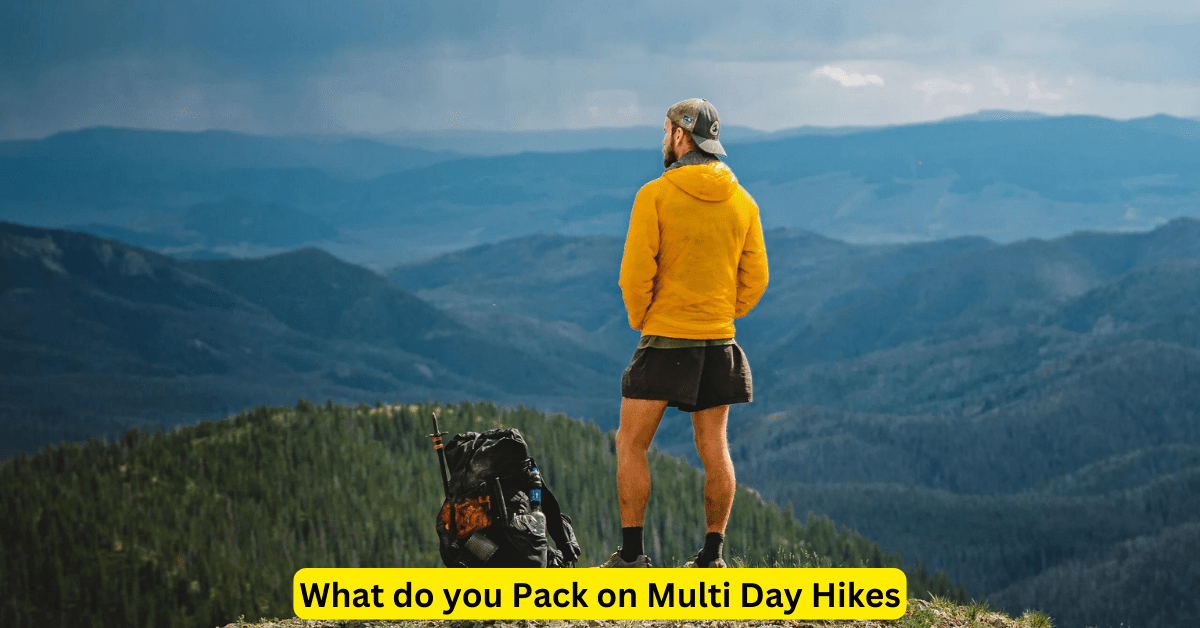Embarking on a multi-day hike is an exhilarating experience, promising stunning vistas, intimate encounters with nature, and a profound sense of accomplishment. However, to ensure a safe and enjoyable journey, proper packing is paramount.
What you bring—or don’t bring—can significantly impact your comfort, safety, and overall experience on the trail. In this comprehensive guide, we’ll delve into the essentials for multi-day hikes, covering everything from clothing and shelter to food and safety gear.
Clothing Essentials

When it comes to clothing for multi-day hikes, the key is to strike a balance between comfort, functionality, and weight. Here’s a breakdown of the essential clothing items to pack:
Clothing Item | Description
- Moisture-wicking Base Layers: Opt for lightweight, breathable materials that wick sweat away from your skin, keeping you dry and comfortable.
- Insulating Layers: Pack insulating layers like fleece or down jackets to stay warm during chilly evenings or unexpected temperature drops.
- Waterproof Shell: A durable, waterproof jacket and pants are essential for staying dry in inclement weather.
- Convertible Pants: Versatile pants that can convert into shorts offer adaptability to changing weather conditions and terrain.
- Hiking Socks: Invest in moisture-wicking, cushioned socks to prevent blisters and keep your feet comfortable on long treks.
- Sturdy Hiking Boots: Choose lightweight yet sturdy hiking boots with good ankle support and traction for navigating various terrain.
Shelter and Sleeping Gear

A good night’s rest is crucial for rejuvenating tired muscles and ensuring you’re ready to tackle the trail each day.
- Tent or Shelter: Choose a lightweight, durable tent or shelter that provides adequate protection from the elements.
- Sleeping Bag: Select a sleeping bag with the appropriate temperature rating for the conditions you’ll encounter on your hike.
- Sleeping Pad: A comfortable sleeping pad provides insulation from the cold ground and enhances overall sleep quality.
- Pillow or Stuff Sack: Consider bringing a compressible pillow or using a stuff sack filled with clothing for added comfort while sleeping.
Prioritize lightweight and compact options to minimize bulk and weight in your pack, but ensure they offer sufficient warmth and protection for a restful night under the stars.
Food and Hydration

Proper nutrition and hydration are vital for maintaining energy levels and sustaining endurance during multi-day hikes. Here’s what to consider when packing food and hydration supplies:
Item | Description
- High-Energy Snacks: Pack lightweight, high-energy snacks like trail mix, energy bars, and dried fruits to fuel your trek.
- Dehydrated Meals: Opt for lightweight, dehydrated meals that require minimal preparation and offer a good balance of carbohydrates, protein, and fats.
- Water Filtration System: Carry a portable water filtration system or purification tablets to safely replenish your water supply from natural sources along the trail.
- Hydration Reservoir or Water Bottles: Stay hydrated by carrying a hydration reservoir or durable water bottles to ensure an adequate intake of fluids throughout the day.
Plan your meals and snacks in advance, considering calorie intake, nutritional value, and weight to optimize your food supply for the duration of your hike.
Safety and Emergency Gear

Exploring the wilderness offers boundless opportunities for adventure, but it also presents potential risks and challenges. As you prepare for your multi-day hike, prioritizing safety by packing the necessary gear can make all the difference in ensuring a smooth journey.
Gear Item | Description
- First Aid Kit: A well-stocked first aid kit is a non-negotiable item for any outdoor excursion. It should include bandages, adhesive tape, antiseptic wipes, gauze pads, tweezers, scissors, pain relievers, antihistamines, blister treatment, and any personal medications. Familiarize yourself with the contents of your kit and ensure it is easily accessible in case of emergencies.
- Navigation Tools: Even if you’re following well-marked trails, it’s crucial to carry navigation tools in case you need to find your way in unfamiliar terrain or if unexpected circumstances arise. Include a detailed map of the area, a compass, and/or a GPS device. Take the time to study your route beforehand and practice using your navigation tools to build confidence in your ability to navigate effectively.
- Emergency Shelter: While you may have planned to spend your nights in a tent, unforeseen circumstances such as extreme weather, injury, or getting lost may necessitate an emergency overnight stay in the wilderness. Pack a lightweight emergency shelter such as a space blanket, bivy sack, or emergency tarp to provide protection from the elements and retain body heat. These compact shelters can be a lifesaver in unexpected situations..
By including these essential safety and emergency items in your pack, you’ll be better equipped to handle unexpected challenges and emergencies that may arise during your multi-day hike. Prioritize safety at all times, stay vigilant, and be prepared to adapt to changing circumstances to ensure a safe and enjoyable outdoor experience.
Conclusion & Recap
Embarking on a multi-day hike is an exhilarating adventure that offers a unique opportunity to connect with nature, challenge yourself, and create lasting memories. As you prepare for your journey, proper packing is essential to ensure your comfort, safety, and overall enjoyment on the trail.
- Clothing Essentials: Choose lightweight, moisture-wicking clothing layers suitable for the expected weather conditions, and prioritize comfort and functionality to enhance your hiking experience.
- Shelter and Sleeping Gear: Invest in a lightweight tent or shelter, a warm sleeping bag, and a comfortable sleeping pad to ensure a restful night’s sleep in the wilderness.
- Food and Hydration: Pack high-energy snacks, dehydrated meals, and a reliable water filtration system to fuel your body and stay hydrated throughout your hike.
By carefully considering each aspect of your packing list and tailoring it to your specific needs and the demands of your hike, you can optimize your gear selection and maximize your enjoyment of the outdoor experience. Remember to always prioritize safety, respect the environment, and leave no trace as you explore the beauty of nature.
As you embark on your multi-day hike, may you find inspiration in the vast wilderness around you, discover new depths of resilience and self-reliance, and forge connections with fellow adventurers and the natural world. Embrace the journey, savor the moments, and cherish the memories created along the way.
Also Read:
What should I pack for a multi-day hike?
Packing for a multi-day hike requires careful consideration of essentials like clothing, shelter, food, and safety gear. Prioritize lightweight, durable items that offer comfort and functionality on the trail.
How do I choose the right backpack for a multi-day hike?
When selecting a backpack, consider factors such as capacity, fit, and features like adjustable straps and padding. Opt for a pack that distributes weight evenly and comfortably accommodates all your gear.
What are the best practices for food storage while camping on multi-day hikes?
Proper food storage is crucial to prevent wildlife encounters and preserve food supplies. Use bear-proof containers or hang food in a secure bear bag away from your campsite to deter animals from accessing your provisions.
How can I prevent blisters and foot pain during long hikes?
To minimize the risk of blisters and foot discomfort, invest in well-fitting hiking boots and moisture-wicking socks. Break in your footwear before hitting the trail, keep feet clean and dry, and address hot spots promptly with blister prevention products.
What safety precautions should I take when hiking in remote areas?
Hiking in remote areas necessitates thorough preparation and awareness of potential hazards. Carry navigation tools, emergency communication devices, and a first aid kit, and inform others of your itinerary before embarking on your journey.
How do I stay hydrated on multi-day hikes?
Maintaining proper hydration is essential for sustained energy and overall well-being while hiking. Carry an adequate supply of water or utilize water filtration systems to replenish your fluids from natural sources along the trail.
What is Leave No Trace (LNT) and why is it important?
Leave No Trace is a set of outdoor ethics promoting responsible recreation and environmental stewardship. It emphasizes minimizing human impact on natural areas by leaving them as undisturbed as possible, preserving their beauty and integrity for future generations.
How should I prepare for changing weather conditions during a multi-day hike?
Weather conditions in the wilderness can be unpredictable, so it’s crucial to be prepared for fluctuations in temperature and precipitation. Pack versatile clothing layers, a waterproof shell, and extra insulation to stay comfortable in varying conditions.
What are some common hiking injuries and how can I prevent them?
Common hiking injuries include strains, sprains, blisters, and sunburn. To prevent injuries, warm up before hiking, wear appropriate footwear, stay hydrated, protect skin from sun exposure, and listen to your body’s signals to avoid overexertion.
How do I minimize my environmental impact while hiking?
Minimize your environmental impact by following Leave No Trace principles, staying on designated trails, disposing of waste properly, and avoiding activities that harm wildlife or damage natural habitats. Leave the wilderness as pristine as you found it for others to enjoy.

